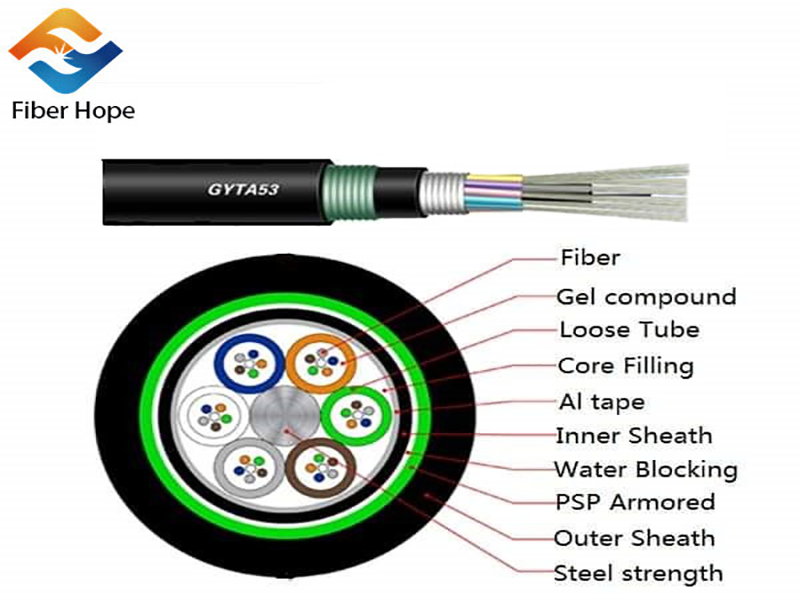Fiber Hope Optical Communication Tech Co.,Ltd.
E-mail:kevin@fh-fiber.com
Fiber Hope optical fiber communication expert & fiber optic cable manufacturer
E-mail:kevin@fh-fiber.com
Fiber Hope optical fiber communication expert & fiber optic cable manufacturer
1. Classification of fiber loss
Optical fiber loss can be roughly divided into the inherent loss of the optical fiber and the additional loss caused by the operating conditions after the optical fiber is made. The specific breakdown is as follows:
Fiber loss can be divided into inherent loss and additional loss:
Inherent losses include scattering losses, absorption losses, and losses due to imperfect fiber structure.
Additional losses include microbending losses, bending losses and splice losses.

Among them, the additional loss is artificially caused during the laying process of the optical fiber. In practical applications, it is inevitable to connect the optical fibers one by one, and the optical fiber connection will produce loss. The slight bending, extrusion, and tensile force of the optical fiber will also cause loss. These are losses caused by the conditions of use of the fiber. The main reason for this is that under these conditions, the transmission mode in the fiber core changes. Additional losses can be avoided as much as possible. Below, we only discuss the inherent loss of fiber.
Among the inherent losses, scattering loss and absorption loss are determined by the characteristics of the fiber material itself, and the inherent loss caused by different operating wavelengths is also different. It is very important to understand the mechanism of loss and quantitatively analyze the loss caused by various factors for the development of low-loss optical fiber and the rational use of optical fiber.
2. Absorption loss of materials
Optical fibers are made of materials that absorb light energy. After the particles in the fiber material absorb the light energy, they vibrate and generate heat, and dissipate the energy, thus resulting in absorption loss. We know that matter is composed of atoms and molecules, and atoms are composed of nuclei and extranuclear electrons. The electrons revolve around the nucleus in a certain orbit. This is just like the earth where we live and the planets such as Venus and Mars all revolve around the sun. Each electron has a certain energy and is in a certain orbit, or each orbit has a certain energy level.
Orbitals closer to the nucleus have lower energy levels, and orbitals farther from the nucleus have higher energy levels. The magnitude of this energy level difference between orbitals is called the energy level difference. When an electron transitions from a low energy level to a high energy level, it absorbs the energy of the corresponding level of energy difference.
In an optical fiber, when electrons of a certain energy level are irradiated with light of a wavelength corresponding to the energy level difference, electrons located in the orbits of lower energy levels will transition to orbits of higher energy levels. This electron absorbs light energy, resulting in light absorption loss.
The basic material for making optical fibers, silicon dioxide (SiO2), itself absorbs light, one is called ultraviolet absorption, and the other is called infrared absorption. At present, optical fiber communication generally only works in the wavelength region of 0.8~1.6μm, so we only discuss the loss in this working region.
The absorption peak generated by electronic transition in quartz glass is around 0.1~0.2μm wavelength in the ultraviolet region. As the wavelength increases, its absorption gradually decreases, but the affected area is wide, up to wavelengths above 1 μm. However, UV absorption has little effect on silica fibers operating in the infrared region. For example, in the visible light region of 0.6μm wavelength, the UV absorption can reach 1dB/km, at 0.8μm wavelength it drops to 0.2~0.3dB/km, and at 1.2μm wavelength, it is only about 0.1dB/km.
The infrared absorption loss of silica fiber is caused by the molecular vibration of the material in the infrared region. There are several vibration absorption peaks above 2μm.
Due to the influence of various doping elements in the fiber, it is impossible for the silica fiber to have a low-loss window in the wavelength band above 2 μm, and the theoretical limit loss at the wavelength of 1.85 μm is 1dB/km.
Through research, it is also found that there are some "destructive molecules" in quartz glass, mainly some harmful transition metal impurities, such as copper, iron, chromium, manganese and so on. Under the irradiation of light, these "bad guys" greedily absorb light energy and jump around, causing the loss of light energy. Eliminating the "troubling molecules" and chemically purifying the material from which the fiber is made can greatly reduce losses.
Fiber hope fiber optic cable and patch cord manufacturers can provide high-quality fiber optic cables,fiber pigtails, fiber patch cords, single-mode multi-mode fiber, welcome to inquiry!
copyright©2025 FIBER HOPE OPTICAL COMMUNICATION TECH CO。,LTD。| All Rights Reserved
Hello, please leave your name and email here before chat online so that we won't miss your message and contact you smoothly.